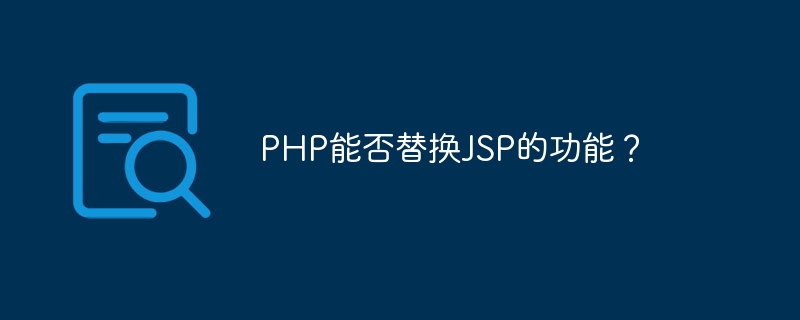Can PHP replace the functionality of JSP?

Can PHP replace the functions of JSP?
As web development technology continues to evolve, developers are often faced with choosing the appropriate server-side language to implement their project needs. In this regard, PHP and JSP are two common choices. JSP is the abbreviation of Java Server Pages, which is a server-side technology based on Java, while PHP is a server-side scripting language. This article will explore whether PHP can replace the functions of JSP, and provide some specific code examples to help readers better understand the differences and connections between them.
First, let’s look at some of the main differences between JSP and PHP. JSP is a Java-based technology that needs to be compiled on the server side before it can be executed, while PHP is an interpreted language that can be directly interpreted and executed on the server side. Since JSP is based on Java, it is more closely integrated with the Java language and can take advantage of Java's powerful features and class libraries. On the other hand, PHP's syntax is more concise and easy to learn, suitable for rapid development of small projects or prototypes.
In practical applications, both PHP and JSP can be used for dynamic web development, including obtaining data from the database and presenting it on the web page. Below we will give a simple example using JSP and PHP respectively, so that readers can better understand the difference between them.
First is an example of JSP:
<%@ page language="java" contentType="text/html; charset=UTF-8"
pageEncoding="UTF-8"%>
<!DOCTYPE html>
<html>
<head>
<meta charset="UTF-8">
<title>JSP Example</title>
</head>
<body>
<%
String message = "Hello, JSP!";
out.println("<h1 id="message">" message "</h1>");
%>
</body>
</html>The following is an example in PHP:
<!DOCTYPE html>
<html>
<head>
<meta charset="UTF-8">
<title>PHP Example</title>
</head>
<body>
<?php
$message = "Hello, PHP!";
echo "<h1 id="message">" . $message . "</h1>";
?>
</body>
</html>The above code shows a simple web page that outputs a message titled "Hello, JSP!" or "Hello, PHP!". It can be seen that JSP uses the tag to insert Java code, while PHP uses the <?php ?> tag to insert PHP code. There are some differences in syntax between the two methods when implementing the same function, but they can both achieve the same effect in practical applications.
In general, PHP and JSP are powerful server-side technologies that can meet the needs of different projects. When choosing which technology to use, developers should consider factors such as the size and complexity of the project, and the familiarity of the development team. I hope the content of this article can help readers better understand PHP and JSP and provide some reference for their project selection.
The above is the detailed content of Can PHP replace the functionality of JSP?. For more information, please follow other related articles on the PHP Chinese website!

Hot AI Tools

Undresser.AI Undress
AI-powered app for creating realistic nude photos

AI Clothes Remover
Online AI tool for removing clothes from photos.

Undress AI Tool
Undress images for free

Clothoff.io
AI clothes remover

AI Hentai Generator
Generate AI Hentai for free.

Hot Article

Hot Tools

Notepad++7.3.1
Easy-to-use and free code editor

SublimeText3 Chinese version
Chinese version, very easy to use

Zend Studio 13.0.1
Powerful PHP integrated development environment

Dreamweaver CS6
Visual web development tools

SublimeText3 Mac version
God-level code editing software (SublimeText3)

Hot Topics
 CakePHP Project Configuration
Sep 10, 2024 pm 05:25 PM
CakePHP Project Configuration
Sep 10, 2024 pm 05:25 PM
In this chapter, we will understand the Environment Variables, General Configuration, Database Configuration and Email Configuration in CakePHP.
 PHP 8.4 Installation and Upgrade guide for Ubuntu and Debian
Dec 24, 2024 pm 04:42 PM
PHP 8.4 Installation and Upgrade guide for Ubuntu and Debian
Dec 24, 2024 pm 04:42 PM
PHP 8.4 brings several new features, security improvements, and performance improvements with healthy amounts of feature deprecations and removals. This guide explains how to install PHP 8.4 or upgrade to PHP 8.4 on Ubuntu, Debian, or their derivati
 CakePHP Date and Time
Sep 10, 2024 pm 05:27 PM
CakePHP Date and Time
Sep 10, 2024 pm 05:27 PM
To work with date and time in cakephp4, we are going to make use of the available FrozenTime class.
 CakePHP File upload
Sep 10, 2024 pm 05:27 PM
CakePHP File upload
Sep 10, 2024 pm 05:27 PM
To work on file upload we are going to use the form helper. Here, is an example for file upload.
 Discuss CakePHP
Sep 10, 2024 pm 05:28 PM
Discuss CakePHP
Sep 10, 2024 pm 05:28 PM
CakePHP is an open-source framework for PHP. It is intended to make developing, deploying and maintaining applications much easier. CakePHP is based on a MVC-like architecture that is both powerful and easy to grasp. Models, Views, and Controllers gu
 CakePHP Routing
Sep 10, 2024 pm 05:25 PM
CakePHP Routing
Sep 10, 2024 pm 05:25 PM
In this chapter, we are going to learn the following topics related to routing ?
 CakePHP Working with Database
Sep 10, 2024 pm 05:25 PM
CakePHP Working with Database
Sep 10, 2024 pm 05:25 PM
Working with database in CakePHP is very easy. We will understand the CRUD (Create, Read, Update, Delete) operations in this chapter.
 CakePHP Creating Validators
Sep 10, 2024 pm 05:26 PM
CakePHP Creating Validators
Sep 10, 2024 pm 05:26 PM
Validator can be created by adding the following two lines in the controller.






